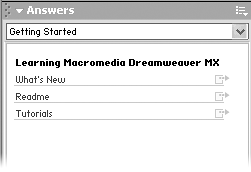Appendix A. Getting Help
Hard as it may be to believe, even this book may not answer all your questions about Dreamweaver. Fortunately, a wide range of other resources awaits when a particular feature doesn’t work for you.
Getting Help from Dreamweaver
There’s plenty of assistance built right into the program, from beginning tutorials to a complete browser-based help system. The new Answers panel (see Figure A-1) provides access to tutorials, articles, extensions, and technical notes—all of which are routinely updated (over the Internet) with new material. You can also access Dreamweaver’s electronic help system and online support center from the Help menu.

Figure A-1. The new Answers panel provides introductory material on the program. Using the menu at the top of the panel, you can choose different answer categories to see most requested technical notes, featured articles, and the newest Dreamweaver extensions.
Getting Started
If you’re brand new to Dreamweaver, see the What’s New presentation, and follow the six step-by-step tutorials that cover specific Web-creation tasks. These range from creating an image map to using Dreamweaver’s dynamic page-building tools. You’ll find them fairly basic (this book’s tutorials cover most of the same ground more thoroughly), but you can never have too much practice. Both of them await in either the Help menu or the Answers panel (choose Window
Get Dreamweaver MX: The Missing Manual now with the O’Reilly learning platform.
O’Reilly members experience books, live events, courses curated by job role, and more from O’Reilly and nearly 200 top publishers.

